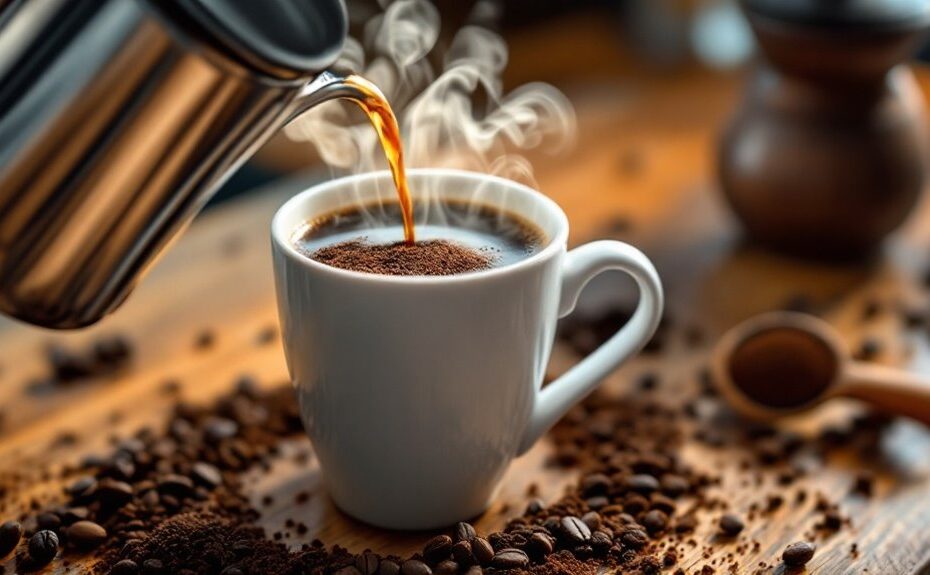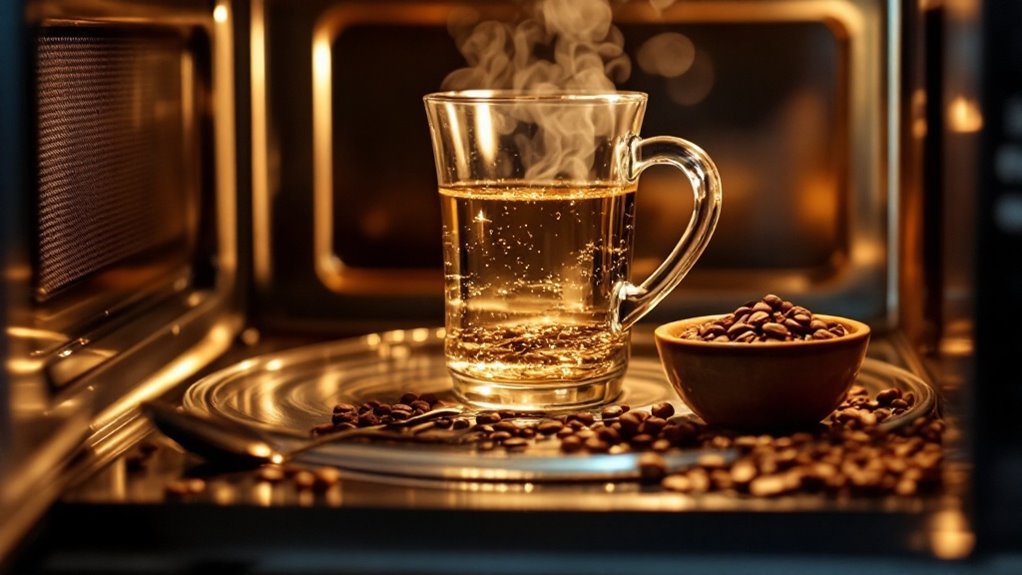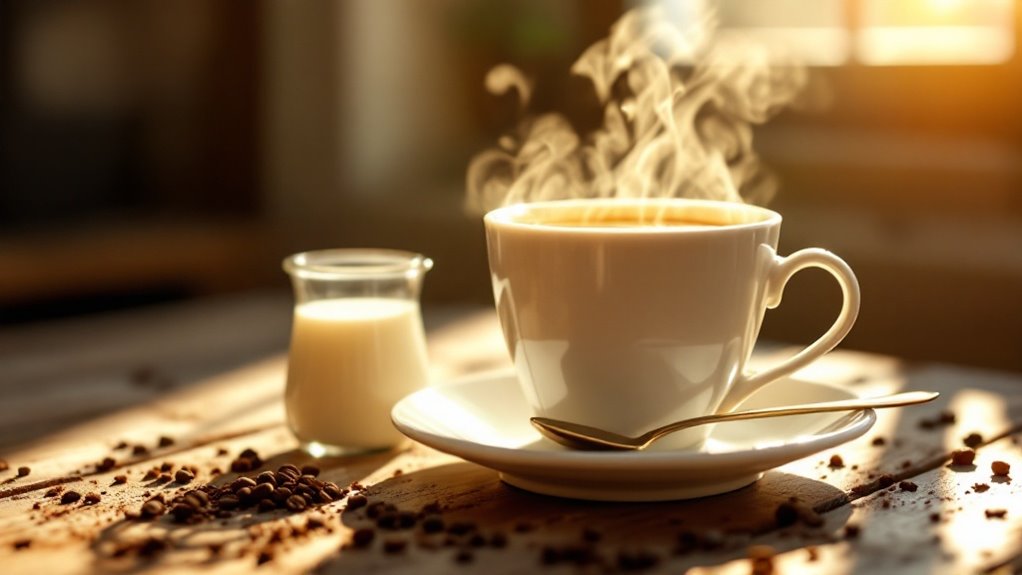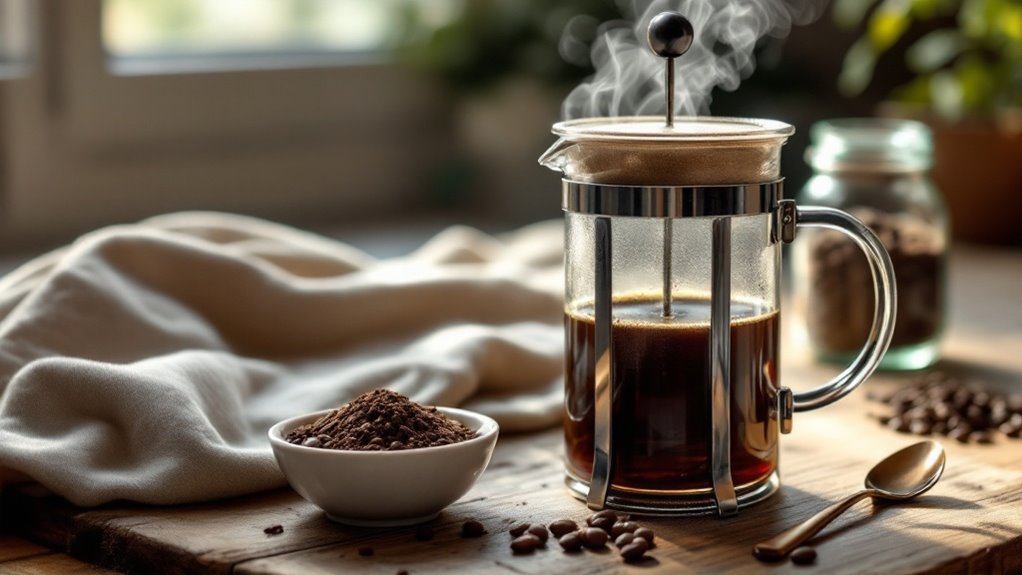







If you're looking to make your coffee stronger, start by adjusting the coffee-to-water ratio—more grounds mean a bolder brew. Opt for dark roast beans and grind them to suit your brewing method, ensuring you extract maximum flavor without bitterness. Water temperature matters too; keep it between 195°F and 205°F for ideal extraction. But what if your coffee still lacks the punch you crave? There's more to explore, from experimenting with brewing techniques to maintaining consistent measurements. The key lies in balancing these elements—so how do you find that perfect combination? Let's uncover the details.
Key Takeaways
- Increase coffee-to-water ratio to 1:15 (11g coffee per 6oz water) for a stronger brew.
- Use dark roast beans for bold flavor and reduced acidity.
- Grind coffee finer for drip methods or coarser for French press to optimize extraction.
- Brew with water between 195°F and 205°F to avoid weak or bitter flavors.
- Clean equipment regularly and use a digital scale for precise measurements.
Adjust Coffee-to-Water Ratio
To amp up the strength of your coffee, start by tweaking the coffee-to-water ratio. The standard ratio for a balanced brew is 1:17, meaning 1 gram of ground coffee for every 17 grams of water. For a stronger brew, increase the coffee-to-water ratio to 1:15, which translates to 11 grams of ground coffee per 6 ounces (177 grams) of water. Use a digital scale to measure both grams of ground coffee and grams of water accurately, ensuring consistency. If you prefer a bolder flavor, experiment with ratios between 1:15 and 1:13, but avoid exceeding 1:12 to prevent under-extraction, which can lead to sour or acidic notes. For example, at a 1:13 ratio, you'd use 13.6 grams of coffee for the same 6 ounces of water. Adjust incrementally, starting from the standard ratio and moving toward stronger ratios to find your ideal coffee strength. Precision is key—too much water dilutes the flavor, while too little can overpower the brew. By mastering the coffee-to-water ratio, you'll achieve a stronger, more robust cup tailored to your taste.
Choose Dark Roast Beans
Dark roast beans' deep, oily surface and bold flavor profile make them a go-to choice for crafting a stronger cup of coffee. When coffee beans undergo a longer roasting process at higher temperatures, they develop a rich, smoky, or chocolatey flavor that's bold and intense. This robust coffee profile is ideal if you're aiming for a strong cup of coffee with minimal acidity. While dark roast beans contain slightly less caffeine than lighter roasts, their concentrated taste and full-bodied texture more than compensate, delivering a powerful sensory experience. To maximize strength, always select freshly roasted coffee beans with a clear roast date, as stale beans lose their potency over time. Dark roast beans are particularly well-suited for brewing methods like espresso or French press, which extract their bold flavors efficiently. Look for beans labeled as French roast, Italian roast, or espresso roast, as these are typically roasted to a dark level. By choosing high-quality dark roast beans, you'll guarantee your coffee is robust, flavorful, and unmistakably strong.
Grind Coffee to the Right Size
Selecting the ideal grind size is critical for achieving a stronger brew, as it directly impacts extraction efficiency and flavor intensity. Use a medium grind (0.5-0.8 mm) for drip coffee, a coarse grind (1.0-1.5 mm) for French press, and a fine grind (0.2-0.3 mm) for espresso to maximize strength without bitterness. Guarantee grind consistency by using a burr grinder, as uniform particles allow for even extraction and a more robust, balanced cup.
Optimal Grind Size Selection
For a balanced and flavorful cup, choosing the right grind size is essential to match your brewing method. The grind size of your coffee grounds directly impacts extraction, influencing strength and flavor. For drip coffee makers, use a medium grind size, resembling granulated sugar, to achieve balanced extraction without over-extraction. If you're brewing with a French Press, opt for a coarse grind size, similar to sea salt, to prevent fine particles from slipping through the mesh filter and introducing bitterness. Espresso demands a fine grind size, akin to table salt, to allow high-pressure water to extract concentrated flavors efficiently. Pour-over coffee methods like V60 or Chemex benefit from a medium-fine grind size, guaranteeing clarity and strength while avoiding filter clogging. For cold brew, an extra-coarse grind size is ideal to prevent over-extraction during the extended steeping process, resulting in a smooth, strong brew. Matching your grind size to your brewing method guarantees ideal extraction, maximizing flavor and strength in every cup.
Grind Consistency Importance
Achieving a consistent grind size plays a crucial role in revealing the full potential of your coffee. Grind consistency guarantees uniform particle size, which is critical for even extraction. Uneven grounds, often produced by blade grinders, lead to inconsistent brewing—some particles over-extract, causing bitterness, while others under-extract, resulting in weak flavors. To avoid this, use a burr grinder, which crushes beans into uniform particle sizes, optimizing extraction and flavor balance.
For drip coffee makers, aim for a medium grind, resembling table salt. This size balances extraction and strength, preventing over- or under-extraction. Finer grinds increase surface area, intensifying flavor extraction but risk over-extraction if too fine, leading to bitterness. Coarser grinds, ideal for methods like French press, allow for a full-bodied, strong brew without over-extraction.
Grind consistency directly impacts the strength and clarity of your coffee. Inconsistent grinds create a muddy cup, masking nuanced flavors. By prioritizing uniform particle size, you guarantee each coffee ground contributes equally to the brew, maximizing strength and flavor. Invest in a quality burr grinder to achieve this precision, and avoid blade grinders, which compromise grind consistency and, ultimately, your coffee's potential.
Adjusting Grind for Strength
To achieve a stronger coffee, adjusting your grind size is one of the most effective methods. A finer grind increases the surface area of the coffee grounds, enhancing extraction and delivering a more robust flavor. For drip coffee, aim for a medium grind, which balances strength and clarity. If you're brewing espresso or using a Moka pot, switch to a fine grind to maximize extraction and intensity. However, avoid grinding too fine for methods like French press, as it can lead to over-extraction and bitterness, masking the coffee's natural flavors.
Invest in a burr grinder to guarantee consistent grind size, which is critical for even extraction. Inconsistent grounds can result in uneven brewing, weakening the overall strength. Adjust your grind size incrementally, testing each setting to find the perfect balance between strength and flavor. Start with small changes, as even a slight adjustment can greatly impact extraction. Remember, the goal is to extract more flavor compounds without crossing into over-extraction territory, which can introduce unwanted bitterness. By mastering grind size, you'll have precise control over your coffee's strength and flavor profile.
Use Optimal Water Temperature
When brewing coffee, the water temperature plays a critical role in determining the strength and flavor of your cup. To achieve ideal extraction, aim for a water temperature between 195°F and 205°F (90°C to 96°C). If the water you use is too cold—below 195°F—it won't extract enough flavor compounds, leaving your coffee weak and sour. Conversely, water above 205°F can scorch the grounds, resulting in bitter, burnt notes.
For precise control, use a variable-temperature kettle to heat your water to the perfect range. If you don't have one, boil water and let it cool for about 30 seconds before pouring it over your grounds. This guarantees the hot water is within the ideal range for your coffee brewing method, whether you're using a drip coffee maker, French press, or pour-over.
The brewing process relies heavily on consistent water temperature to extract the right balance of acids, oils, and sugars. By maintaining this precision, you'll enhance the strength and complexity of your coffee, guaranteeing a robust and flavorful cup every time.
Experiment With Brewing Methods
If you're aiming to make your coffee stronger, experimenting with different brewing methods can substantially impact the intensity and flavor profile of your cup. Start by adjusting the coffee-to-water ratio to suit your preferred brew method. For a French Press, use a 1:12 ratio and steep for 4 minutes to extract a full-bodied, robust flavor. If you prefer a cleaner, crisp finish, try a pour-over with a 1:15 ratio and a slow, controlled pour. For a concentrated, espresso-like brew, a Moka Pot with a 1:8 ratio delivers bold results. Espresso machines, using a 1:2 to 1:3 ratio under high pressure, produce a rich, intense shot. Alternatively, cold brew offers a smooth, strong coffee with low acidity when steeped at a 1:4 ratio for 12-24 hours. Each method requires precise measurements to avoid over-extraction while maximizing strength. By tailoring your brew method and ratio, you can make coffee that's stronger and more flavorful, aligning with your taste preferences. Experimentation is key to finding the perfect balance for your coffee maker.
Avoid Over-Extraction and Bitterness
Over-extraction and bitterness can undermine even the strongest coffee, turning a robust brew into an unpleasant experience. To avoid this, you must carefully control your brewing time, water temperature, and grind size. Over-extraction occurs when water interacts with coffee grounds for too long, extracting excessive tannins and caffeine, which create bitter flavors. For drip coffee, aim for a brewing time of 4-6 minutes; exceeding this range risks over-extraction. Water temperature also plays a critical role—keep it between 195°F and 205°F (90°C-96°C). Temperatures above 205°F can scorch the grounds, leading to burnt, bitter flavors. Use a medium grind size for drip methods, as finer grinds increase surface area and extraction rate, heightening the risk of bitterness. Additionally, maintain a balanced coffee-to-water ratio of 1:16. Using too little water relative to coffee grounds can cause over-extraction and sourness, while too much water dilutes the brew. By optimizing these variables, you'll achieve a strong, flavorful cup without the unwanted bitterness or sourness that detracts from the coffee's natural richness.
Use Freshly Roasted Coffee Beans
Always choose freshly roasted coffee beans with a roast date within the last 2-4 weeks to guarantee peak flavor and aromatic intensity. Store them in an airtight container at room temperature, away from light and heat, to preserve their volatile oils and prevent oxidation. Grind the beans immediately before brewing to extract the fullest, boldest flavors for a stronger cup.
Optimal Roast Date
For the strongest and most flavorful coffee, start with beans roasted within the past 2-4 weeks. Freshly roasted beans release more aromatic oils, which contribute to a richer, more robust brew. Always check the roast date on the packaging to confirm your beans are within their peak freshness window. Beans older than four weeks lose their aromatic oils and volatile compounds, resulting in a weaker, less vibrant cup. Choose whole bean coffee over pre-ground, as grinding accelerates the loss of these essential oils and diminishes flavor intensity. When selecting your beans, prioritize those with a clearly marked roast date to secure the best flavor. Once you've purchased your beans, transfer them to an air-tight container to preserve their freshness and protect them from oxidation. Avoid exposing the beans to light, heat, or moisture, as these factors degrade their quality. By focusing on the roast date and using freshly roasted beans, you'll maximize the strength and complexity of your coffee, guaranteeing a bold and satisfying experience every time.
Proper Storage Techniques
After selecting freshly roasted coffee beans with a roast date within the past 2-4 weeks, proper storage becomes key to maintaining their strength and flavor. Store your coffee in an airtight container to protect it from oxygen, which degrades the beans' oils and aromatic compounds. Choose a container made of ceramic, glass, or stainless steel with a tight-sealing lid. Keep the container in a cool, dark place, ideally between 60-70°F (15-21°C), away from direct sunlight, heat sources, and moisture. Avoid refrigerating or freezing your coffee beans, as temperature fluctuations can cause condensation, leading to flavor loss and staleness. For peak freshness, use your coffee beans within 2-4 weeks of roasting. Grind only the amount you need right before brewing, as freshly ground coffee releases its full flavor and strength immediately. Pre-ground coffee loses its potency quickly due to increased surface area exposure to air. By following these precise storage techniques, you'll guarantee your coffee beans retain their robust flavor and deliver a consistently strong brew.
Maintain Consistent Measurements
To achieve a consistently strong cup of coffee, precise measurements are essential. Use a digital scale to measure both coffee grounds and water by mass, guaranteeing precise ratios every time. A rule of thumb for a standard brew is a 1:17 coffee-to-water ratio, meaning 10 grams of coffee for every 6 ounces of water. If you prefer a stronger cup, adjust the ratio incrementally, such as 1:15, to intensify the flavor without compromising balance. Avoid relying on volume measurements like tablespoons, as coffee grounds vary in density, leading to inconsistent results. By maintaining consistent measurements, you guarantee even extraction, preventing under-extraction (sourness) or over-extraction (bitterness). Record your preferred ratios to replicate the same strength in future brews. This approach not only enhances flavor but also allows you to fine-tune the amount of coffee to water for your ideal cup. Precision is key—small adjustments in ratios can greatly impact the final taste, so stick to your digital scale and precise ratios for a reliably strong brew.
Clean and Maintain Brewing Equipment
Keeping your brewing equipment clean is just as important as precise measurements for achieving a consistently strong cup of coffee. Start by cleaning your coffee maker after every use to prevent oil buildup and stale flavors, which can weaken the strength and taste of your brew. Descale your machine monthly using a 1:1 mixture of white vinegar and water to remove mineral deposits that can clog internal components and reduce brewing efficiency. Replace water filters regularly to guarantee clean, fresh-tasting water, as impurities can alter the flavor and strength of your coffee. If you use reusable metal filters, wipe them down after each use to prevent residue buildup, which can lead to uneven extraction and weaker coffee. Don't forget to check and clean the brew basket and carafe to remove old coffee grounds and oils that can compromise the strength and quality of your brew. By maintaining a clean coffee maker, you'll guarantee peak performance and a consistently robust cup every time.
Disclosure: As an Amazon Associate, I earn from qualifying purchases.






